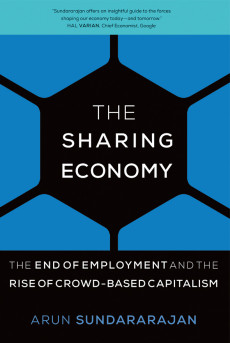
The Sharing Economy: The End of Employment and the Rise of Crowd-Based Capitalism
Arun Sundararajan
204 pages, MIT University Press, 2016
When I search th e phrase “sharing economy” on Amazon. com, I get a list of about 2,600 books and related items; the same search on Google Scholar yields about 200,000 articles. The sharing economy appears to be a very well-investigated area, even though Uber, Airbnb, TaskRabbit, and most other peer-to-peer digital platforms that support it didn’t exist 10 years ago. But only a small fraction of this writing has an academic focus, and The Sharing Economy, by Arun Sundararajan, a professor at New York University’s Stern School of Business, is a welcome arrival. Bringing together his own research and the work of scholars in economics, sociology, psychology, and computer science, Sundararajan offers a valuable analysis of how this new economy is reshaping society, creating more decentralized systems, and raising questions about how to build trust within them.
The book’s strength is its economic perspective on the factors fueling the sharing economy. “While the geneses of today’s sharing economy date back at least two decades and some of these precursors, like eBay and Craigslist, continue to exist, the promise could not be fully realized until the economy had been sufficiently digitized,” Sundararajan writes. He argues that three main technical developments enabled the sharing economy to emerge: the ability to render physical things (money, music, manufacturing processes) as digital information; increasingly powerful and compact hardware; and the spread of modular software applications that build on each other. This digital expansion, he writes, is allowing decentralized, networked markets and crowd-based capitalism to play a larger role in an economic system long dominated by large, hierarchical companies.
Sundararajan is optimistic about these changes’ democratizing effects. He argues that by empowering a broader range of people to access services and earn income from their assets as well as wages, the sharing economy can help build community and promote equality. But he is inconsistent in how he describes the sort of trust needed to bring about these developments. As the lead trust scientist at Uber, I know firsthand the importance of building trust among users. And I think that Sundararajan’s book, which focuses heavily on technical aspects of building trust, could have benefited from a deeper discussion of trust’s human, interpersonal aspects.
Early on, Sundararajan says that crowdbased exchange platforms such as eBay were sharing-economy precursors but do not count as real members of the sharing economy because they didn’t demand the same level of trust that services like Uber and Airbnb do today. A vital question for peer-to- peer platforms was, “How does one move from generating the level of trust needed to receive a UPS box from a stranger, and get to the level where people are willing to get into a stranger’s car and say, ‘Drive me to another city’?” In other parts of the book, though, Sundararajan seems to overlook the importance of interpersonal trust and to treat the sharing economy as the same thing as the broader crowd-based economy. In fact, crowd-based capitalism includes many schemes, such as Amazon Mechanical Turk, Kickstarter, and ShareDesk, that are not necessarily part of the sharing economy and don’t require high levels of trust.
When Sundararajan does focus on trust, his examples of the ways that the sharing economy can build it are largely technical—they focus on how platforms can verify digital identities and bolster their brand. Whereas personal interactions formed the basis of the trust behind “the informal couchsurfing of previous eras,” a user ratings system allows the 21st-century company CouchSurfing International to rely on “the possibility of a trust built through the platform rather than through a history of personal contact.” Sundararajan suggests that as the sharing economy develops, it may be able to diminish its reliance on interpersonal trust in any form by adopting blockchain technology, the crowd-based process behind Bitcoin that uses cryptography to verify transactions.
Currently, however, none of the sharing economy’s major players—Airbnb, Lyft, etc.—rely on blockchain for their daily operations. And that may in part be because trust between strangers is not the same thing as successful coordination of economic activity, a point not always clear in the book. What Sundararajan sees as a cumulative, perhaps linear process of aggregating levels of trust may actually be a process riddled with tensions. A recent Harvard University study of more than 6,000 Airbnb users across five US cities found that hosts were about 16 percent less likely to respond positively to applicants for lodging with names that sounded African-American. Findings such as these show that the digital sharing economy has the potential to reproduce rather than counteract real-world inequalities, or even worsen them when a lack of initial in-person interaction means that users are more likely to base whom they trust on prejudices. Technical solutions can promote coordination but not necessarily trust.
Perhaps a certain degree of tension is inevitable in a book that seeks to appeal to many different audiences. Some sections are more academically oriented; others are clearly more directed at a general readership. Overall, though, the book should be successful in engaging both audiences and, hopefully, in encouraging more research on the sharing economy.

